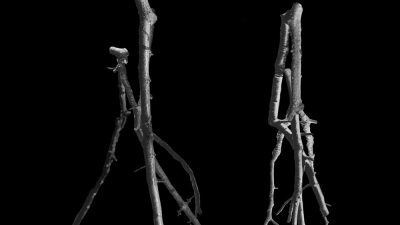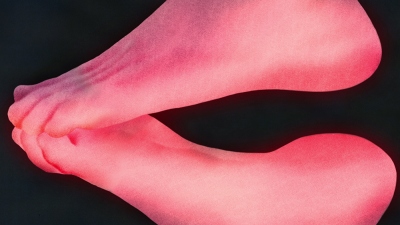Agnieszka Polska
Five Short Videos
In Agnieszka Polska's Five Short Videos, as if in a psychoanalyst’s office, the viewer becomes a hypnotized patient – short, three-minute films are presented to them simultaneously on five screens. Just describing them may be a subjective, dream-like interpretation that says more about the viewer’s subconscious than about what is actually presented. Combined with the sound of monotonous, repetitive music, the images of feet, fingers and crystals touching each other may suggest both abstract play and evoke erotic associations; a green drop falling into the auricle may be associated with surrealism or The Murder of Gonzago from Hamlet, which is the first ever use of a séance as a psychological phenomenon on stage; the changing angle of the shadow cast by a light bulb challenges the idea of movement; the marching branches evoke references to fantasy, and the wheel resembling the sun rising from above its own reflection in the water poses questions about what is constant and what is relative.
Agnieszka Polska (born 1985) is one of the most interesting Polish artists of the young generation. In 2011, she won the main prize in the Eugeniusz Geppert painting competition in Wrocław; a year later her films were shown at the Tate Modern in London. Polska was also among the 20 artists nominated for the Future Generation Prize 2012, an award for young artists funded by the Ukrainian collector Viktor Pinchuk, the founder of the contemporary art centre in Kiev – Pinchuk Art Center.
In her work, Polska uses photography, animation, video and collage. She is interested in the mechanisms of memory, which, due to its imperfection, is close to creation. Polska’s animated films are based on the idea of reviving archival materials, such as old photos. Her source materials are often pre-war newspapers, books, black and white photos from the sixties and seventies, including documentation of works of art. This borrowed aesthetic determines the atmosphere of her works, as if rooted in somewhat idealized visions of the past. The artist shows how misunderstandings resulting from reading what has been archived and thus deprived of its original context, may lead to the emergence of new insights. Her strategy resembles the work of a critical archivist – she is less interested in what has actually been archived and much more in what hasn’t. Thanks to this, her works balance on the border between reality and fiction, and the viewer remains uncertain as to the status of the presented material: they are not always able to decide what is Polska’s artistic creation and what is a historical document.


